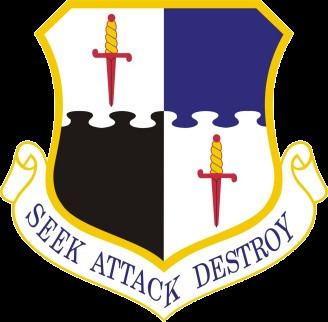Active 1948–present | ||
 | ||
Part of United States Air Forces in Europe - Air Forces Africa Motto(s) "Seek, Attack, Destroy" | ||
The 52d Fighter Wing (52 FW) is a wing of the United States Air Force stationed at Spangdahlem Air Base, Germany. It was activated in 1948, but derives significant elements of its history from the predecessor Second World War 52d Fighter Group, which is now the 52d Operations Group, subordinate to the wing.
Contents
Etymology
52d Fighter Wing is the official military nomenclature of the unit and it is commonly referred to as the 52nd Fighter Wing. It is often interchanged within military writing and speech, either way, without a specific choice of nomenclature. The Air Force Instruction Publication (Air Force Instruction 38-101), Chapter 5; "Procedures for Naming and Numbering Units", figure 5.1, gives an example of using 2nd Bomb Wing, and section 5.4.2; "Unit Kind", gives an example of 3rd Wing. Section 5.3.4. - Reserves numbers 101 through 299 for Air National Guard units giving position for the unit numbering.
Mission
The 52 FW maintains, deploys and employs F-16CJ and A/OA-10 aircraft and TPS-75 radar systems in support of NATO and the national defense directives. The wing supports the United States Air Forces in Europe - Air Forces Africa (USAFE-AFAFRICA), Supreme Allied Commander Europe with mission-ready personnel and systems providing expeditionary air power for suppression of enemy air defenses, close air support, air interdiction, counter-air, air strike control, strategic attack, combat search and rescue, and theater airspace control. The wing also supports contingencies and operations other than war as required.
Overview
The wing conducts operations at Spangdahlem Air Base, Germany, one of 16 major operating locations in USAFE. The wing is authorized for about 5,560 active-duty members and about 210 Department of Defense civilians. The wing is organized with four groups responsible for operations, maintenance, mission support and medical operations, and has headquarters staff.
In concert with USAFE wings at Ramstein Air Base, Germany, the 52d Fighter Wing directly supports the strategic mobility mission once conducted at Rhein-Main Air Base, Germany. The wing provides logistics support for C-17 Globemaster III and C-5 Galaxy aircraft, crew, passengers and cargo to sustain air mobility operations throughout Europe, Africa and Southwest Asia.
The 52d Fighter Wing also supports USAFE's Joint Fires Center of Excellence, whose mission is to conduct joint and combined training focused on the effective integration and application of tactical fires.
Subordinate organizations
52d Operations Group (52 OG)
52d Maintenance Group (52 MXG)
52d Medical Group (52 MDG)
52d Mission Support Group (52 MSG)
52d Munitions Maintenance Group (52 MMG) (custody and storage of tactical nuclear weapons)
History
See 52d Operations Group for World War II lineage and historyCold War
Established as the 52nd Fighter Wing, All Weather, on 10 May 1948, the wing served in the United States as an air defense unit in the northeastern United States from 1947 until the end of 1968.
The 52nd was reactivated on 18 August 1955 and designated 52d Fighter Group (Air Defense). It was assigned to Air Defense Command and equipped with F-86 Sabre aircraft. It served once more as an air defense unit in the northeastern United States.
In December 1971, it became the host wing at Spangdahlem Air Base, Germany, and inherited tactical squadrons from the 36th Tactical Fighter Wing at nearby Bitburg Air Base. The wing participated in numerous tactical exercises, operations, and tests of USAFE and NATO and provided close air support, interdiction, and base defense operations. It cooperated with other NATO forces in frequent "squadron exchange" programs and hosted US-based units on temporary duty in Europe. In January 1973, a Wild Weasel defense suppression mission was added. After October 1985, using the F-4 Phantom II model aircraft, defense suppression became the wing's sole tactical mission. In 1987, the 52d acquired F-16 Falcons and became the first wing to integrate F-16Cs with F-4Gs to form hunter/killer teams within individual fighter squadrons.
It deployed aircraft and personnel to strategic locations in Saudi Arabia and Turkey in support of the liberation of Kuwait from September 1990 – March 1993. Near the end of 1992, it began receiving A-10 Thunderbolt II aircraft. It received F-15 Eagles in 1994 but lost its F-4Gs. In January and December 1999, the wing supported Operations Northern Watch, Allied Force, and Decisive Forge with numerous deployments to Italy and Turkey.
Modern era
Following the terrorist attacks on the World Trade Center and The Pentagon in the United States on September 11, 2001, the 52d Fighter Wing began preparations for possible combat tasking.
Within one month the wing had deployed people and equipment in support of Operation Enduring Freedom in and around Afghanistan. The 22d Expeditionary Fighter Squadron began flying operations at a deployed location in support of the war on terrorism within 100 hours of tasking notification.
Personnel assigned to the 52d FW continue to deploy in support of Operation Enduring Freedom today.
In April 2010 the wing's strength was reduced by one third. Twenty F-16Cs were flown to the 148th Fighter Wing, Minnesota Air National Guard, one F-16 was transferred to Edwards Air Force Base, California. All aircraft were from the 22nd Fighter Squadron. As a result of the drawdown of F-16s, the 22nd and 23rd Fighter Squadrons were inactivated on 13 August 2010 and formed the a single "new" squadron, the 480th Fighter Squadron.
On 18 June 2013, the 81st Fighter Squadron was inactivated at Spangdahlem Air Force Base in Germany. The inactivation marked the end of A-10 operations in Europe at that time.
In December 2014, the wing commander, Col. Peter Bilodeau, who had commanded the wing for six months, was relieved of his command for "a loss of faith and confidence in his leadership." His deputy served as commander until Col. McFall took command.
Lineage
Components
Wing
Group
Squadrons
